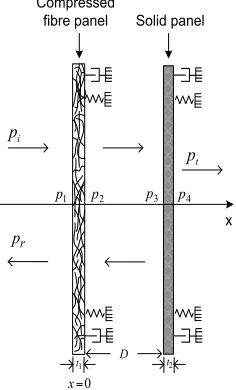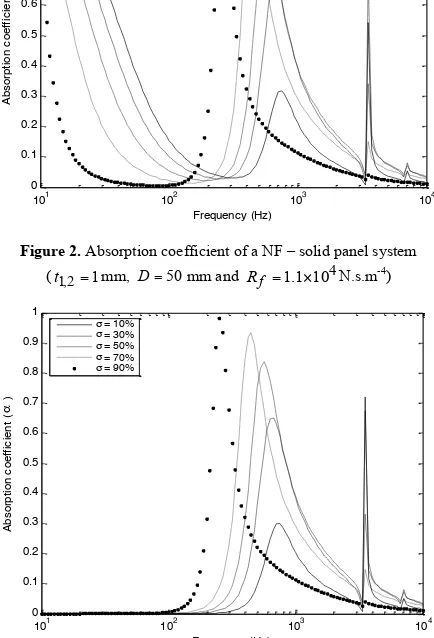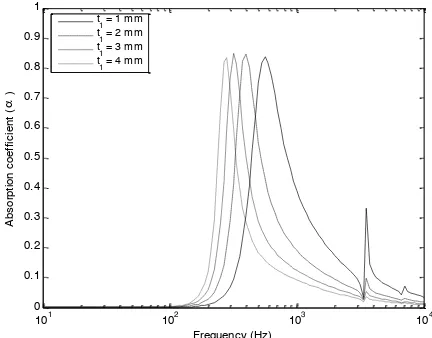Melaka, Malaysia 4 – 6 April 2012
MODELLING THE EFFECT OF VIBRATION ON THE SOUND
ABSORPTION PERFORMANCE OF GREEN SOUND ABSORBER USING
WAVE PROPAGATION TECHNIQUE
M. Sajidin Py.
*, Azma Putra,
Norliana Salleh and Hady Efendy
Faculty of Mechanical Engineering,
Universiti Teknikal Malaysia Melaka, Melaka, Malaysia. Email: *[email protected]
Abstract— Natural fibers (NF) have been known to have good acoustic performance and can potentially substitute the classical synthetic absorber materials which give negative impact for the environment. Commonly, the sound absorption model available for porous acoustic panel ignores the vibration of the panel. In this paper, the effect of the vibration on the sound absorption of the NF panel backed with a solid panel and air layer is modeled using wave propagation method. It is shown that the model can be adjusted into the case of an absorber panel backed with air layer and rigid surface by increasing the impedance of the solid panel.
Keywords—Microperforated Panel, Absorption Coefficient, Wave Propagation, Natural Waste Material, Fiber.
I. INTRODUCTION
A good acoustic performance particularly for the speech intelligibility is important in a building such as an auditorium. To increase the sound absorption, the room walls and ceilings are covered by absorptive layers using glass wools or acoustic foams made from synthetic chemical substance. These type materials not only have negative impacts concerning their risk on pollution, health and fire hazard, but also contribute to CO2
pollution in their fabrication that triggers global warming.
A. Green sound absorbers
Until recently, many studies focused in investigating organic or natural fiber (NF) as sound absorber materials are still progressing. Natural materials give more advantages than synthetic ones as they are renewable and available in abundance amount in certain countries. Previous researchers have investigated the potential of the NF as sound absorbers. Ersoy and Kucuk [1] investigated the industrial waste of tea leaf fiber as an acoustic material. It is found that this gave promising result for significant frequency range. Zulkifli et al. [2]worked on coir and oil palm fibers on their acoustic properties.Both are compressed under pressure to form a fiber sheet. It is shown that both natural wastes have good sound absorption particularly at high frequency. Lindawati et al. [3] measured sound absorption of Arenga Pinnata fiber. The result indicated that it has good absorption from mid to high frequency. Abdullah et al. [4] investigated natural waste fibers from dried paddy straw. Good acoustic performance is found at frequency above 2000 Hz.
Apart from finding potential natural fibers to produce environmentally friendly sound absorber, the newest method is the employment of a microperforated panel
(MPP) as a non-fibrous sound absorber. Its theory and design were pioneered by Dah You Maa [5] in 1975. Typically, the system consists of a panel with submilimetric holes backed by an air cavity and a rigid wall. The diameter of the hole should be less than 1 mm and the perforation ratio is between 0.5 – 1.5%.
B. Existing models for sound absorption coefficient
The existing conventional model for MPP and also porous absorber is for the case of the panel backed by an air layer and a rigid wall. The sound absorption coefficient is given by
(
[
]
)
2[
]
2Im Re
1
] Re[ 4
tot tot
tot
Z Z
Z
+ +
=
α
(1)where the
Re
[
Z
tot]
and Im[
Ztot]
denotes the real andimaginary part of the surface acoustics impedance of the panel.
Eq. (1) assumes the panel as a rigid frame, i.e. ignoring the effect of panel vibration due to impinging sound pressure.
Sakagami et al. [6] investigates the effect of induced vibration for double panels of MPP using the Helmholtz-Kirchhoff integral. The results show that the vibration improves the sound absorption of the MPP only at the resonance.
The effect of flexural vibration on a porous absorber panel was proposed by Takahashi and Tanaka [7] employing the Helmholtz integral formula and Green’s function to numerically calculate the acoustics pressure acting on the panel. It is also found that the vibration increases the sound absorption.
This paper proposes a simpler analytical model to calculate the absorption coefficient of a thin porous absorber by including the effect the panel vibration using the wave propagation method.
II. MATHEMATICAL MODEL
Fig. 1 shows the diagram of the NF-solid panel system separated by distanceDexcited by sound pressure. The incident, reflected and transmitted of sound pressure at the system are, respectively given by
p
i=
A
~
e
−jkx (2)
jkx r
B
e
Compressed fibre panel i p t p r p Solid panel 1
p p2 p3 p4
D 0 = x 1 t x 2 t
Figure 1. Mechanical system of a NF – solid panel
p
t=
C
~
e
−jkx (4)where
k
=
ω
c
is the acoustic wavenumber,ω
and care angular frequency and the speed of sound respectively.The acoustic pressure acting on the porous panel surface p1 and p2at x = 0 and on the solid panel surface
3
p and p4at x = D are given by
p
1=
p
i+
p
r=
A
~
1e
jkx+
B
~
1jkx=
A
~
1+
B
~
1− (5)
2 2 2 2 2
~ ~ ~ ~ B A B e A
p = −jkx + jkx = + (6)
jkD jkD
B
e
A
p
3 2 2~
~
+
=
− (7)
p
4=
ρ
cv
p2 (8)where
2 p
v is the velocity of the solid panel and A~and
B~are the complex pressure amplitudes.
Using Euler equation
~
v
=
−
1
j
ρω
(
∂
p
∂
x
)
at x = 0 for1
p andp2, the sound particle velocity at the surface of the panels can be written as
1 1
(
~A1 B~1)
cv = −
ρ
(9)2 1
(
A~2 B~2)
cv = −
ρ
(10)On the porous elastic plate surface the particle velocity is given by [6]
σ γ ξ x p Z v v c p I ∂ ∂ −
= 1 (11)
whereξI =1−
[
γZc]
reactσ γZcwith γ is the propagation constant, Zc is the characteristic impedance and σ is theporosity. For quantities γ and Zc empirical models
developed by Allard [8] are used.
Substituting Eqs. (9) and (10) into Eq. (11) yields mean the sound particle velocity at x = 0+ and x = 0–, respectively − = c p I z c jk v v
γ
σ
ρ
ξ
1 11 ,
− = c p I z c jk v v
γ
σ
ρ
ξ
1 12 (12)
Using Eq. (6), Eq. (7) can be written as
p
3=
p
2cos
kD
−
j
ρ
cv
2sin
kD
(13)Using Euler equation for Eq. (7) then substituting Eqs. (6) and (10) yields
j kD cv kD v c p p sin cos 2 2 2
ρ
ρ
−= (14)
Substituting Eq. (14) into Eq. (13) gives
(
)
kD j kD v v c p p sin cos 2 2 3 −=
ρ
(15)The equation of motion of the solid panel is given by
Zp2vp2 =
(
p3−p4)(
1−σ
)
(16) where2 p
Z is the impedance of the solid panel.
Substituting Eqs. (8), (12) and (15) into Eq. (16) and after mathematical manipulation
Θ −
= (1 )
2
σ
v
vp (17)
where Θ= jZp sinkD
ρ
c+(
1−σ
)
ejkD2 is the
non-dimensional term.
The equation of motion of the NF panel is given by
Zp1`vp1 =
(
p1−p2)(
1−σ
)
(18)where 1 p Z and 1 p
v are the impedance and the velocity of
the NF panel, respectively.
Substituting Eq. (5) and (14) into Eq. (18) yields the surface velocity at the solid panel
(
)
[
σ
]
σ
ξ
ρ
ξ
σ
− − Θ − + ΘΩ Θ − = 1 ) 1 ( sin sin ) 1 ( ~ 2 1 1 jkD I p I e c kD jZ kD A jv (19)
where Ω=
(
1−jkρcσ γZc)
is the non-dimensional term.The reflection coefficient Rat x = 0 is given by
i r
p p
R= (20)
Melaka, Malaysia 4 – 6 April 2012
(
)
[
(
)
]
(
σ
)
[
(
σ
)
]
ξ
ρ
σ
σ
ξ
ρ
− − Θ − + ΘΩ − − Θ − + ΘΩ = − 1 1 sin 1 1 sin 1 1 jkD I p jkl I p e c kD jZ e c kD jZR (21)
The absorption coefficient of NF-solid panel can be calculated as
2 1−R
=
α
(22)Note that absorption coefficient defined here includes the transmission loss of the system.
III. RESULT AND DISCUSSION
Fig. 2 shows the theoretical results of absorption coefficient of NF back with solid panel and air layer. The calculation was done by varying the porosity and by fixing the flow resistivity Rf . It can be seen that
absorption coefficient at low frequency below 100 Hz decreases as the porosity increases. This corresponds to the transmission loss of the system. For frequency range 200 – 1000 Hz, the sound absorption increases as the porosity increases. This relates the absorption of
101 102 103 104
0 0.1 0.2 0.3 0.4 0.5 0.6 0.7 0.8 0.9 1
Porous Panel - Solid Panel
Frequency (Hz) Ab s o rp ti o n c o e ff ic ie n t ( α )
σ = 10% σ = 30% σ = 50% σ = 70% σ = 90%
Figure 2. Absorption coefficient of a NF – solid panel system
(t1,2=1mm, D=50mm and Rf =1.1×104N.s.m-4)
101 102 103 104
0 0.1 0.2 0.3 0.4 0.5 0.6 0.7 0.8 0.9 1
Porous Panel - Solid Panel
Frequency (Hz) Ab s o rp ti o n c o e ff ic ie n t ( α )
σ = 10%
σ = 30%
σ = 50%
σ = 70%
σ = 90%
Figure 3. Absorption coefficient of a NF – rigid backing system (t1,2=1 mm,D=50mm and
4 10 1 . 1 × = f
R N.s.m-4)
the sound energy by the air layer between the panels. The case of an NF panel backed by air layer and an infinite rigid surface can be obtained by setting large value for the solid panel impedance Zp in Eq. (21). The
results are shown in Fig. 3 where the absorption coefficient below 100 Hz is now suppressed into zero as the sound transmitted behind the solid panel has been blocked.
The Fig. 4 plots the results for different air layer thickness. The thickness of the air layer backing the NF corresponds to the maximum peak of the sound absorption coefficient. The corresponding frequency of this peak shifts to lower frequency if the air layer thickness is increased.
Fig. 5 presents for different flow resistivity of the NF panel which indicates that absorption increases as the flow resistivity reduces.
Fig. 6 plots the results for different thicknesses of the porous panel of NF-rigid backing system. It can be seen that the thinner panel not only shift the performance to higher frequency but also widen the frequency range. This is due to the effect of vibration on the NF panel which increases the loss of sound energy.
101 102 103 104
0 0.1 0.2 0.3 0.4 0.5 0.6 0.7 0.8 0.9 1
Porous Panel - Solid Panel
Frequency (Hz) Ab s o rp ti o n c o e ff ic ie n t ( α )
D = 10 mm D = 30 mm D = 50 mm D = 70 mm
Figure 4. Absorption coefficient of a NF – rigid backing system (t1,2=1mm, σ=50% and Rf =1.1×104N.s.m-4)
101 102 103 104
0 0.1 0.2 0.3 0.4 0.5 0.6 0.7 0.8 0.9 1
Porous Panel - Solid Panel
Frequency (Hz) Ab s o rp ti o n c o e ff ic ie n t ( α ) R
f = 1.1x10 4
R
f = 2.2x10 4
R
f = 3.3x10 4
R
f = 4.4x10 4
R
f = 5.5x10 4
101 102 103 104 0
0.1 0.2 0.3 0.4 0.5 0.6 0.7 0.8 0.9 1
Porous Panel - Solid Panel
Frequency (Hz)
Ab
s
o
rp
ti
o
n
c
o
e
ff
ic
ie
n
t
(
α
)
t 1 = 1 mm t
1 = 2 mm t
1 = 3 mm t
1 = 4 mm
Figure 6. Absorption coefficient of NF – rigid backing system (t2=1mm,σ=50%, D=50mm,Rf =1.1×104N.s/m4)
IV. CONCLUSION
The sound absorption coefficient of a NF-solid panel system has been formulated by wave propagation method for normal incident sound by considering the vibration of the panel. The model is attractive as the solid panel can be adjusted to a rigid wall by increasing the impedance of the solid panel into infinity (very large value). It is found that vibration of the NF panel widen the frequency range of the absorption coefficient. The model can also be extended to the case of oblique and diffuse field incidence which consider the bending stiffness of the NF panel.
ACKNOWLEDGMENT
The authors would like to acknowledge the Ministry of Higher Education (MoHE) Malaysia for supporting this work under Fundamental Research Grant Scheme; FRGS/2010/FKM/SG03/7-F00095.
REFERENCES
[1] S.Ersoy and H. Kucuk. Investigation of industrial tea-leaf-fibre waste material for its sound absorption properties. Applied Acoustics, 70, 2009, pp.215-220.
[2] R. Zulkifli, M.J.M. Nor, A.R. Ismail, M.Z. Nuawi, S. Abdullah, M.F.M. Tahir, and M.N.A. Rahman, Comparison of Acoustic Properties between Coir Fibre and Oil Palm Fibre. European Journal of Scientific Research, 33(1), 2009, pp.144-152.
[3] L. Ismail, M.I. Ghazali, S. Mahzan, A.M. A. Zaidi, Sound Absorption of Arenga Pinnata Natural Fiber. World Academy of Science, Engineering and Technology, 67, 2010, pp.808-806.
[4] Y. Abdullah, A. Putra, H. Efendy, W.M. Farid, and M.R. Ayob, Investigation on Natural waste Fibers from Dried Paddy Straw as a Sustainable Acoustic Absorber. In: CD-ROM proceedings of First Conference on Clean Energy and Technology (CET), Kuala Lumpur, 2011. pp. 311-314. [5] D.Y. Maa, Theory and Design of Microperforated Panel
Sound-Absorbing Contructions. Scientecia Sinica, XVIII(1), 1975, pp.55-71.
[6] K. Sakagami, K. Matsutani, and M. Morimoto, Sound absorption of a double-leaf micro-perforated panel with an air-back cavity and a rigid-back wall : Detailed analysis with a
Helmholtz – Kirchhoff integral formulation. Applied Acoustics, 71(5), 2010, pp.411-417.
[7] D. Takahashi and M. Tanaka, Flexural vibration of perforated plates and porous elastic materials under acoustic loading. Acoustical Society of America, 112,2002, pp. 1456-1464. [8] J.F. Allard and Y. Champoux, New empirical equations for


